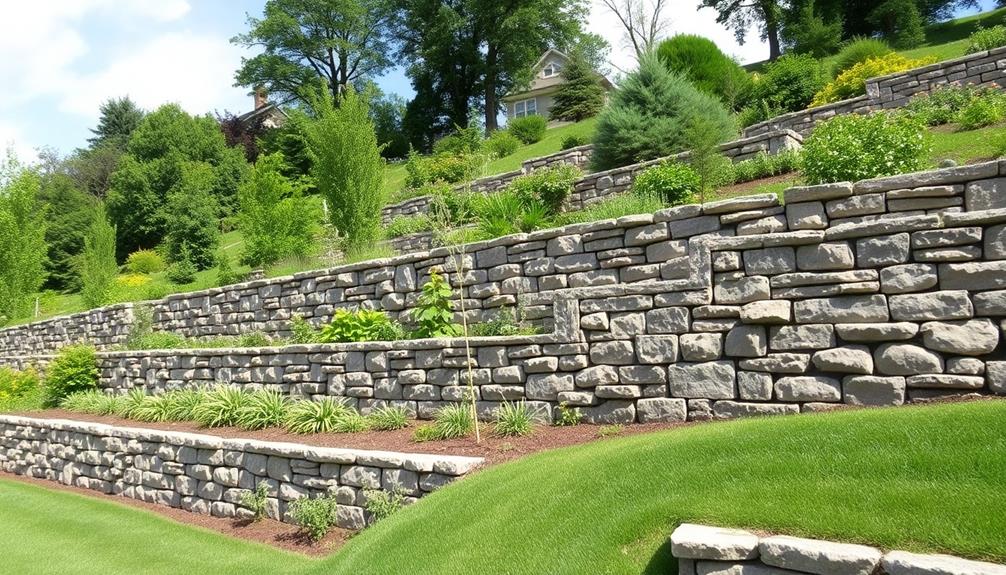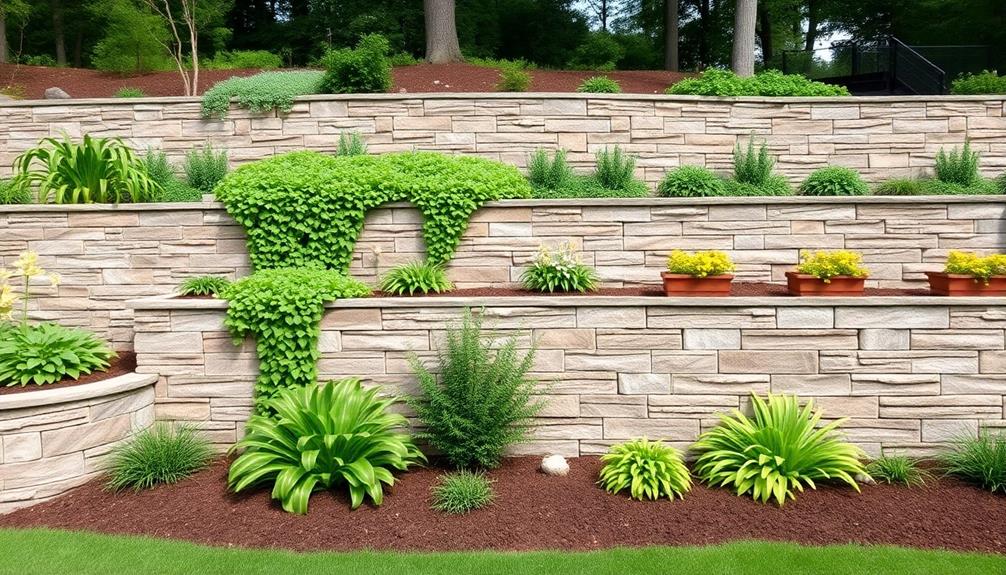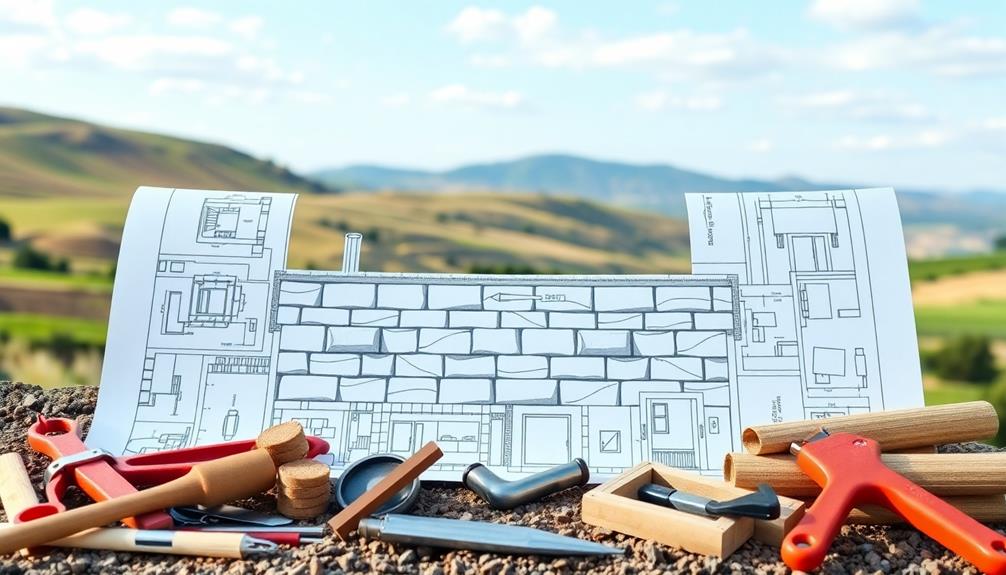Effective retaining wall design hinges on understanding site conditions, choosing suitable materials, and meticulously planning drainage and foundational elements. It is crucial to assess topography, soil type, and environmental impacts while selecting materials that fulfill durability and aesthetic requirements. Proper drainage systems are indispensable to prevent water accumulation, utilizing methods like weep holes and geotextiles. Establishing a solid foundation through precise excavation and reinforcement is essential for stability. Adhering to safety standards and local regulations guarantees compliance, and professional consultation further optimizes the design process. Explore these elements closely to enhance both functionality and visual appeal of retaining walls.
Table of Contents
ToggleWalls Contractor Highlights
- Assess site conditions, including topography and soil type, to determine the wall's design requirements.
- Choose durable materials that integrate aesthetically with the landscape and meet building codes.
- Incorporate an effective drainage system to prevent water buildup and ensure wall stability.
- Establish a solid foundation using compacted gravel for support, considering soil bearing capacity.
- Consult with professionals for compliance with local regulations and effective structural design.
Purpose of Retaining Walls

Retaining walls serve a vital role in both functional and aesthetic aspects of landscape management by mitigating the adverse effects of soil erosion and enhancing the visual appeal of outdoor spaces. These structures not only preserve the integrity of sloping terrain by preventing soil displacement but also offer versatile designs that elevate the aesthetic value of the environment.
Boulder walls are particularly excellent for stairways and large walkways, providing customizable dimensions and location while enhancing the overall landscape appeal. Additionally, retaining walls provide essential structural support by withstanding lateral pressures from the soil, ensuring stability, especially in areas subject to significant load or environmental stress.
Erosion Control Benefits
With their fundamental role in landscape stabilization, retaining walls offer significant erosion control benefits by preventing soil displacement. Designed to combat the natural forces of water and gravity, they form an indispensable element in preserving terrain integrity.
Erosion can cause detrimental effects on both natural landscapes and constructed environments by gradually weakening soil structures. Retaining walls efficiently mitigate these effects by providing necessary structural support, which restricts the erosion process and aids in maintaining the soil's steadfast nature.
These walls utilize engineering principles that channel water flow, reducing its velocity and potential to wash away topsoil. By incorporating proper drainage systems, retaining walls guarantee that water percolates through designated paths, thereby preserving the intended landscape design and soil consistency.
Additionally, they can be strategically placed to protect valuable vegetation, thus fostering a cohesive ecosystem that can further resist erosive forces.
Moreover, retaining walls provide homeowners and communities a sense of security, knowing their properties are shielded from potential landslides and soil loss, fostering a connection to their environment. They serve as a physical and metaphorical bulwark, allowing individuals to enjoy their shared spaces while protecting natural resources responsively.
Landscape Aesthetic Enhancement
Beyond their practical benefits in erosion control, retaining walls also considerably enhance the aesthetics of a landscape, adding both beauty and utility to outdoor spaces. These structures provide a harmonious blend of functionality and visual appeal, creating inviting environments that resonate with those who seek a sense of community and connection.
Visually attractive retaining walls introduce an architectural element that defines and organizes outdoor areas, transforming uneven terrains into purposeful and usable spaces.
The choice of materials, from natural stones to textured concrete blocks, opens up a multitude of possibilities for customizing the wall to align with the existing landscape and architectural style, enhancing the sense of belonging. Careful design considerations, such as the integration of plantings, lighting, and other decorative elements, further enhance the wall's appeal, seamlessly merging built and natural aspects of the surroundings.
The versatility of these walls allows them to serve as backdrops for gardens, terraces, and gathering spaces, fostering environments where individuals feel welcome.
Structural Load Support
Commonly essential in both residential and commercial landscapes, retaining walls primarily serve the vital function of providing structural load support. This indispensable role involves preventing soil erosion and managing gravity-induced soil pressures, thereby safeguarding infrastructure and enhancing the stability of various terrains.
When engineered meticulously, retaining walls offer enduring solutions that uphold the integrity of terraces, embankments, and sloped spaces, fostering the harmonious co-existence of built environments and natural landscapes.
Retaining walls expertly address the challenges of topographical deformations by transferring lateral earth pressures into vertical loads, minimizing the likelihood of landslide occurrences. This beneficial manipulation of forces helps maintain the desired landscape arrangement without compromising safety or functionality.
Engineers and landscape architects utilize a range of construction materials, including concrete, stone, and timber, each selected for its capacity to withstand anticipated pressures while aesthetically aligning with surrounding elements.
For communities and property owners seeking durability and elegance, customizing retaining walls to their unique environmental conditions guarantees not only prolonged structural functionality but also a sense of belonging with the terrain. Appropriately designed and installed retaining walls symbolize commitment to preserving the environment, contributing to the stability and aesthetic appeal of your living space.
Benefits

Implementing an effective retaining wall design offers a multitude of benefits that profoundly enhance both functionality and aesthetics in landscape architecture. These structures play a pivotal role in enhancing structural integrity by stabilizing uneven terrains and mitigating soil erosion risks, thereby protecting property and landscape investments.
Retaining walls also serve as decorative extensions of homes, adding visual appeal while directing rainwater away from the foundation. In addition, retaining walls maximize usable space on sloped areas, creating additional opportunities for landscaping or construction, while also contributing to the overall aesthetic appeal of the surrounding environment by adding dimension and texture.
Enhances Structural Integrity
A well-designed retaining wall drastically enhances the structural integrity of any landscape by preventing soil erosion and managing lateral earth pressures effectively. These structures are indispensable, acting as guardians that reinforce stability in terrains where levels change, ensuring that properties remain secure and aesthetically pleasing.
By supporting slopes and creating level areas, retaining walls mitigate risks associated with shifting soils, which can otherwise compromise the foundational stability of landscaping elements or adjacent structures.
Incorporating specialized engineering techniques, retaining walls counteract the natural inclinations of soil movement, effectively distributing and balancing horizontal earth pressures that otherwise push against the vertical planes they stabilize. This equilibrium not only sustains the wall's own durability but also contributes to the long-term perseverance of the terrain it supports, providing a reliable framework for both natural and constructed landscapes.
Moreover, using materials such as concrete, stone, or engineered blocks, modern retaining walls can be tailored to meet the unique demands of different environments, blending seamlessly while fortifying the landscape's innate resilience. As a collective asset to communities, these structures nurture a shared sense of belonging and security, anchoring locales with a steadfast foundation that meets both practical and aesthetic aspirations.
Prevents Soil Erosion
Retaining walls' strategic incorporation into landscape design plays a pivotal role in preventing soil erosion, a primary concern in maintaining the health and stability of both natural and developed environments. Their importance cannot be overstated, as these structures effectively act as barriers that halt the displacement of soil on slopes and embankments.
By intercepting and redistributing rainfall run-off, retaining walls mitigate the potential for soil to wash away, thereby preserving fertile topsoil and minimizing degradation.
Moreover, retaining walls provide structural reinforcement that aids in maintaining the integrity of sloped areas prone to erosion. Concrete, stone, or other durable materials offer resilience to adverse weather conditions, thereby ensuring long-term protection. Whether through terracing or tiered designs, these walls blend functionality with aesthetic appeal, which brings peace of mind to communities invested in protecting their landscapes.
In terms of environmental sustainability, retaining walls contribute substantially by reducing sedimentation in adjoining bodies of water, preventing harmful ecological implications. By controlling soil movement, these structures prevent the pollution of waterways with agricultural runoff, which otherwise exacerbates water quality issues. In this manner, retaining walls foster a sense of stewardship, uniting community efforts in protecting valuable natural resources.
Maximizes Usable Space
One of the most significant benefits of retaining walls is their ability to maximize usable space within a landscape. By cleverly transforming sloped areas, retaining walls create flat, functional surfaces, which can be utilized for various purposes such as gardens, patios, or play areas. This transformation not only enhances the practicality of the land but also fosters a sense of community engagement, as households can interact more comfortably within their improved environments.
In urban areas where space is at a premium, this benefit cannot be overstated, as it allows for efficient land use, inviting residents to participate more fully in shared outdoor activities.
The strategic positioning of retaining walls can redefine the contours of a property, facilitating the addition of terraced areas that blend seamlessly with the surroundings. This acquired space becomes a blank canvas for property owners, who can shape it to meet their lifestyle needs while simultaneously increasing the property's functionality.
The incorporation of such practical structures serves as a memorial, affirmation, or record to the balance between engineering ingenuity and environmental sensitivity. By maximizing usable space, retaining walls not only support the physical integrity of the terrain but also enhance the communal experience, fostering a deeper sense of belonging among individuals.
Improves Aesthetic Appeal
Beyond maximizing usable space, well-designed retaining walls considerably enhance the aesthetic appeal of a landscape. A thoughtfully crafted retaining wall not only integrates seamlessly into the surrounding environment but also elevates the visual cohesion and allure of the area. By blending functional needs with artistic elements, these structures serve as both practical and decorative components that enrich outdoor spaces.
Incorporating varied materials, textures, and styles, retaining walls can transform an ordinary landscape into a visually compelling environment. They offer numerous possibilities for personal expression and community identity within public or private settings.
Material Versatility: From natural stone to modern concrete or brick, the choice of material considerably influences the overall look and feel.
Texture and Color: Retaining walls offer diverse textures and color schemes that align with existing elements or provide striking contrasts.
Architectural Style: They can reflect classical, contemporary, or rustic designs, enhancing the thematic coherence of a property.
Landscape Integration: Well-designed retaining walls subtly incorporate natural contours, creating a balanced and harmonious appearance.
Focal Points: These structures often serve as dramatic focal points, inviting the admiration of both inhabitants and visitors.
Local Building Regulations Compliance

Compliance with local building regulations is a critical aspect of retaining wall design, verifying both legal adherence and robust structural integrity. Understanding permit requirements, adhering to zoning laws, and considering safety standards are essential components that must be meticulously accounted for during the planning phase. The following table outlines key considerations in local regulation compliance, highlighting the interconnected nature of each factor:
| Key Aspect | Description | Importance |
|---|---|---|
| Permit Requirements | Documentation needed to initiate project | Confirms legal authorization and oversight |
| Zoning Laws | Regulations on land use and boundaries | Maintains community standards and order |
| Safety Standards | Guidelines for construction practices | Safeguards public welfare and property |
| Environmental Impact | Assessment of ecological considerations | Promotes sustainable development |
| Structural Compliance | Alignment with engineering guidelines | Guarantees long-term stability and safety |
Understanding Permit Requirements
Traversing the intricacies of local building regulations is a crucial step in effective retaining wall design. Understanding and securing the proper permits aids in ensuring not only legal compliance but also contributes to successful project execution. This process begins by consulting relevant municipal authorities to identify specific requirements tailored to the geographic and environmental conditions of the area.
Typically, a retaining wall project might necessitate a comprehensive application that includes detailed engineering drawings and specifications. Evaluating these requirements upfront avoids costly delays and guarantees alignment with community standards.
Acquiring permits often entails maneuvering varying degrees of documentation and approval channels, with key considerations including:
- Structural integrity assessments: Verify that the wall meets safety benchmarks.
- Environmental impact studies: Minimize disruptions to local ecosystems.
- Site surveys: Detail the terrain and existing site conditions.
- Material specifications: Ensure usage of appropriate building materials.
- Inspections and sign-offs: Facilitate periodic checks by qualified personnel.
Securing the appropriate permits creates a collaborative framework with local authorities, enhancing not only compliance but contributing to overall communal harmony. Recognizing the shared benefits of well-regulated construction engenders a sense of belonging within a community that values safety and enduring quality in structural development.
Adhering Zoning Laws
Adhering to zoning laws is fundamental to local building regulations compliance when designing a retaining wall. Understanding and applying these legal restrictions is imperative to avoid potential disputes and promote a streamlined project execution. Zoning laws dictate specific land use requirements and limitations regarding property structures, including retaining walls. They may encompass aspects such as wall height, distance from property lines, and overall structural footprint, making it essential for project developers to review these laws meticulously.
Consulting with local authorities or a seasoned legal expert can confirm comprehensive adherence to governing regulations, thereby fostering community alignment and averting legal challenges. Additionally, familiarity with zoning laws contributes to creating trust and engagement within the local community, as it shows adherence not only to rules but to the collective values that guide communal living.
Understanding these constraints also provides more room for creative, compliant solutions in wall design, optimizing both functionality and aesthetics. Emphasizing zoning laws in your design strategy underscores your commitment to responsible development, ensuring the creation of structures that seamlessly integrate into their environment. Each step of alignment confirms respect for the established urban framework, ensuring collective advancement toward sustainable architectural practices.
Safety Standards Considerations
Guaranteeing robust safety standards in retaining wall design is indispensable for promoting structural integrity and public safety. Compliance with local building regulations is not merely a procedural formality but a fundamental aspect that supports the longevity and reliability of these structures, ultimately fostering communal well-being. The conformance to established guidelines provides assurance that the wall can safely endure environmental pressures and prevent possible failures.
In the execution of a retaining wall project, consider the following essential safety standards:
- Material Specifications: Use materials that meet local quality standards, ensuring durability and resilience against natural forces.
- Load-Bearing Calculations: Accurately assess and design for the expected loads, including soil pressure and potential surcharges, to prevent overloading.
- Drainage Solutions: Implement effective drainage systems to mitigate hydrostatic pressure that can compromise wall stability.
- Erosion Control: Incorporate elements that protect against soil erosion, which may undermine foundational integrity over time.
- Professional Certification: Engage licensed professionals who are well-versed in local regulations to guarantee compliance and perfect design execution.
Adhering to these standards is pivotal not only in creating a sense of trust within the community but also in achieving a harmonious balance between architectural function and environmental responsibility. Through meticulous planning and a commitment to best practices, the safety and success of retaining wall designs are safeguarded.
Walls Contractor FAQ
How Do I Determine the Appropriate Materials for a Retaining Wall?
To determine appropriate materials for a retaining wall, evaluate soil conditions, load requirements, and environmental factors. Consider durability, aesthetics, and costs. Engage with industry experts and leverage collective knowledge to guarantee the project aligns with community standards and values.
What Are Common Mistakes to Avoid When Designing a Retaining Wall?
When designing a retaining wall, avoid inadequate site analysis, underestimating drainage requirements, and selecting materials that are unsuitable for environmental conditions. Consider the community's aesthetic preferences and guarantee compliance with local regulations to foster harmonized and resilient structures.
How Can I Ensure Proper Drainage for My Retaining Wall?
Ensuring proper drainage for a retaining wall involves installing perforated drain pipes behind the wall and incorporating gravel backfill. Sufficiently spaced weep holes within the structure facilitate water flow, preventing hydrostatic pressure, thereby ensuring the wall's integrity.
What Tools Are Necessary for Constructing a Retaining Wall?
To construct a retaining wall effectively, essential tools include a laser level for accurate alignment, a compactor for soil stability, a masonry saw for precise cuts, plus safety equipment. These tools guarantee project success and team confidence.
How Do I Choose the Right Retaining Wall Style for My Landscape?
When selecting a retaining wall style, consider the landscape's natural elements, desired aesthetics, and functional needs. Engage with design experts to guarantee the chosen style complements the environment, enhancing both harmony and visual appeal for the community.







